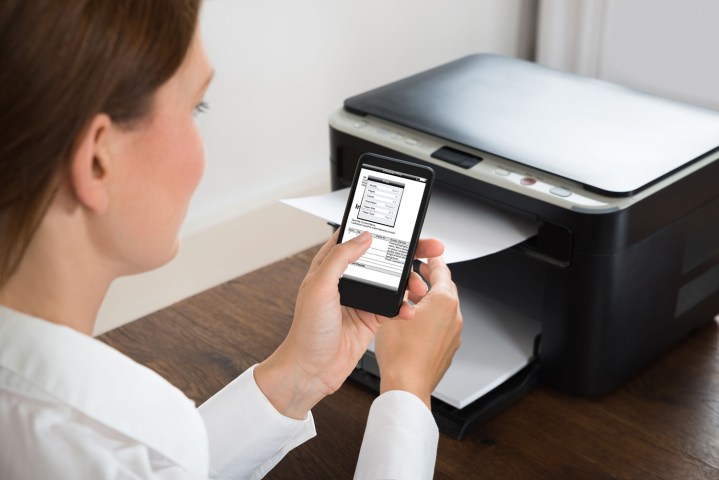
Do a physical checkup

It’s always smart to start with the basics, so head on over to your printer and make sure all the hardware is functioning as expected. Double-check that the power cable is plugged into both the outlet and the printer. Make sure the printer doesn’t have to be manually switched on. If your printer has a screen, check it for any error messages or warnings. Clear out any surprise paper jams you find and, of course, turn your computer/printer off and then back on again to see if that clears things up. This is all common-sense stuff, but you don’t want to miss anything obvious before moving onto more software-oriented solutions.
Run the printer troubleshooter
With Windows 10, Microsoft has included a bevy of automatic troubleshooters that you can download and run from the internet to help diagnosis your problems. One of these troubleshooters is designed for printers, and it should be your first software stop. After all, if you can fix your printer issues automatically, why waste time?
To start, head over to this Microsoft support page. Part way down you will see a blue button that says “Run troubleshooter.” Select it, and the troubleshooter should start running automatically.
The troubleshooter will look for any errors in your printing software, and if it finds them it will report those errors to you. In some cases the troubleshooter will also be able to suggest automatic solutions such as particular updates or new drivers to fix the problem. Follow the suggestions the troubleshooter gives you, then reboot your computer and see if the fix worked.
If the troubleshooter gives you an error message but no automatic fixes, take note of the error: It typically offers valuable clues about where to look next in your network or system.
Update or replace your drivers
Drivers are like little translator modules in your operating system, turning digital data into a language that your particular printer can understand when it’s getting ready to print. You can see why many common issues, such as failure to complete a printing task, are related to drivers. The problem is that drivers don’t always update at the same time as Windows, usually vary between brands, and aren’t always compatible with other software. If the printer troubleshooting program didn’t fix your driver issue, it might need some extra aid. To help sort out the mess, here are three steps you should take to fix your driver issues. Stop after each step to see if it fixed your printer issue!
- Remove your printer. Head over to the Start menu and enter “Device manager” into the search box. Select the appropriate location. When the Devices window opens, look at the sidebar for Printers & scanners. In this section you will see all the printers that Windows 10 recognizes. Head over to the printer that has problems and select it. You will see an option to “Remove device.” Select this and confirm. Then go up to “Add a printer or
scanner” and add that same printer model again (Windows 10’s autodetect is a big timesaver here). This solution gives Windows a push to check for any driver updates that may be required for the printer. Sometimes a fresh start is all that’s needed.
- Update Windows 10. If you have automatic updates to Windows 10 turned off or otherwise disabled, you may have missed an important update that the OS and drivers need to successfully communicate. A few of our previous steps (restarting your computer, running the troubleshooter) may have encouraged these updates, but if that didn’t work then you can update more directly. Search for “Settings” and open the window. Select Updates & Security from the list, and then go to Windows Update. Here, select Check for Updates to make sure that all current updates have been applied. Start any updates that may be available. Once they have finished, reboot your computer and try your printers again.
Note: This step is also a good option to fix more esoteric printer problems. For example, certain Windows 10 updates (specifically, those in August 2016) created unintended printer bugs that caused printers to only print a single page, then stop, or corrupt every printjob they were assigned. Bugs like these do get patched over time, but you need to make sure you install all the latest updates for Windows 10 so you don’t leave an error unresolved.
- Replace individual printer drivers. You can also update drivers for individual printers more directly, which is a two step process. The first step is a Windows 10 driver search: Start by searching for Device Manager and selecting it. Go the Printers & Scanners section, and find your printer. Right click on the printer, and choose Update Driver Software. This will give you an option to “Search automatically for updated driver software.” See if Windows can find a new driver for you and download it if possible (administrator authorizations may apply).
If Windows doesn’t find any new drivers, there’s one last thing you can try. Do an online search for drivers for your particular brand and model number. Many brands, like HP and Xerox, have their own pages devoted to Windows 10 printer drivers. Check for any recent drivers or driver issues that the manufacturers are reporting.
Targeted solutions for settings issues
If all else fails, there are a few Windows 10 settings you can tweak that may solve less common printer problems. Here are two options that have proved helpful to many people just minutes away from throwing their printers out the window:
Default printer settings: Do you find that your default printer keeps switching and you never know where your pages will end up? A strange Windows 10 setting can switch default printers to whichever printer was last used – which can cause chaos in the office or classroom. To fix this issue, head over to Devices and go to the Printers & scanners Scroll down and look for the heading that says, “Let Windows manage my default printer.” Make sure this option is turned off. Now when you assign a default printer, it will stay that way.
- Firewall settings: Sometimes firewall settings can interfere with your printer network connections. This is not nearly so common as it once was, but if you are having trouble communicating with your printer you can try turning off the OS firewall to see if that helps. Search for the Control Panel, head over to System and Security, then go to
Windows Firewall. Look for the option that says “Turn Windows Firewall on or off.” Switch the Windows Firewall off, enter any necessary authorization, and try your printer again. As Windows quickly informs you, it’s not a good idea to leave the firewall off for an extended length of time, especially if you don’t have any third party security.
Editors' Recommendations
- Windows 11 might nag you about AI requirements soon
- You’re going to hate the latest change to Windows 11
- The most common Windows 11 problems and how to fix them
- The most common GoTo Meeting problems and how to solve them
- Windows 11 tips and tricks: 8 hidden settings you need to try



 scanner” and add that same printer model again (Windows 10’s autodetect is a big timesaver here). This solution gives Windows a push to check for any driver updates that may be required for the printer. Sometimes a fresh start is all that’s needed.
scanner” and add that same printer model again (Windows 10’s autodetect is a big timesaver here). This solution gives Windows a push to check for any driver updates that may be required for the printer. Sometimes a fresh start is all that’s needed.

 Default printer settings: Do you find that your default printer keeps switching and you never know where your pages will end up? A strange Windows 10 setting can switch default printers to whichever printer was last used – which can cause chaos in the office or classroom. To fix this issue, head over to Devices and go to the Printers & scanners Scroll down and look for the heading that says, “Let Windows manage my default printer.” Make sure this option is turned off. Now when you assign a default printer, it will stay that way.
Default printer settings: Do you find that your default printer keeps switching and you never know where your pages will end up? A strange Windows 10 setting can switch default printers to whichever printer was last used – which can cause chaos in the office or classroom. To fix this issue, head over to Devices and go to the Printers & scanners Scroll down and look for the heading that says, “Let Windows manage my default printer.” Make sure this option is turned off. Now when you assign a default printer, it will stay that way. Windows Firewall. Look for the option that says “Turn Windows Firewall on or off.” Switch the Windows Firewall off, enter any necessary authorization, and try your printer again. As Windows quickly informs you, it’s not a good idea to leave the firewall off for an extended length of time, especially if you don’t have any third party security.
Windows Firewall. Look for the option that says “Turn Windows Firewall on or off.” Switch the Windows Firewall off, enter any necessary authorization, and try your printer again. As Windows quickly informs you, it’s not a good idea to leave the firewall off for an extended length of time, especially if you don’t have any third party security.


